Analysis of Travel Decision-Making for Urban Elderly Healthcare Activities under Temporal and Spatial Constraints
Abstract
:1. Introduction
2. Methods
2.1. Healthcare Constraint Degree
2.2. Concept of HCD
3. Research Design and Analysis
3.1. Questionnaire Design
- (1)
- Personal attributes included sex, age, educational background, occupation, personal monthly income, living condition and medical insurance.
- (2)
- The characteristics of the demand for healthcare included types of diseases, medical facilities, waiting time for a healthcare service, medical charges, accessibility of medical treatment, and purpose of travel.
- (3)
- The characteristics of healthcare activities included the medical facilities, the consumption of entire healthcare activities, any accompaniment by a family member, the mode of travel, the distance of travel, travel time and travel frequency.
- (4)
- Travel ability included walking time and the time waiting for a bus.
3.2. Data Source
3.3. Data Analysis
3.3.1. Transportation Structure of Healthcare
3.3.2. The Characteristics of Healthcare Time
3.3.3. Healthcare Constraint Degree Measurement
4. Modeling Travel Mode Choice
4.1. Improved Logit Model
4.2. Calibration of Influence Variables
5. Results and Discussion
5.1. Model Result
5.2. Model Discussion
6. Conclusions
Author Contributions
Funding
Acknowledgments
Conflicts of Interest
References
- Rosenbloom, S. Sustainability and automobility among the elderly: An international assessment. Transportation 2001, 28, 375–408. [Google Scholar] [CrossRef]
- Alsnih, R.; Hensher, D.A. The mobility and accessibility expectations of seniors in an aging population. Transp. Res. Part A 2003, 37, 903–916. [Google Scholar] [CrossRef]
- Acker, V.V.; Goodwin, P.; Witlox, F. Key research themes on travel behavior, lifestyle, and sustainable urban mobility. Int. J. Sustain. Transp. 2016, 10, 25–32. [Google Scholar] [CrossRef] [Green Version]
- Scheiner, J. Social inequalities in travel behaviour: Trip distances in the context of residential self-selection and lifestyles. J. Transp. Geogr. 2010, 18, 679–690. [Google Scholar] [CrossRef]
- Fernándezolano, C.; Hidalgo, J.D.; Cerdádíaz, R.; Requenagallego, M.; Sánchezcastaño, C.; Urbistondocascales, L.; Oteropuime, A. Factors associated with health care utilization by the elderly in a public health care system. Health Policy 2006, 75, 131–139. [Google Scholar] [CrossRef] [PubMed]
- Owens, G.M. Gender differences in health care expenditures, resource utilization, and quality of care. J. Manag. Care Pharm. 2008, 14, 2–6. [Google Scholar] [CrossRef] [PubMed]
- Fisher, L.J.; Goldney, R.D. Differences in community mental health literacy in older and younger Australians. Int. J. Geriatr. Psychiatry 2003, 18, 33. [Google Scholar] [CrossRef] [PubMed]
- Fyffe, D.C.; Brown, E.L.; Sirey, J.A.; Hill, E.G.; Bruce, M.L. Older Home-Care Patients’ Preferred Approaches to Depression Care: A Pilot Study. J. Gerontol. Nurs. 2008, 34, 17–22. [Google Scholar] [CrossRef] [PubMed]
- Diala, C.; Muntaner, C.; Walrath, C.; Nickerson, K.J.; Laveist, T.A.; Leaf, P.J. Racial Differences in Attitudes Toward Professional Mental Health Care and in the Use of Services. Am. J. Orthopsych. 2000, 70, 455–464. [Google Scholar] [CrossRef]
- Bessho, S.; Ohkusa, Y. When do people visit a doctor? Health Care Manag. Sci. 2006, 9, 5–18. [Google Scholar] [CrossRef] [PubMed]
- Borah, B.J. A mixed logit model of health care provider choice: Analysis of NSS data for rural India. J. Health Econ. 2006, 15, 915–932. [Google Scholar] [CrossRef] [PubMed]
- Sarma, S. Demand for outpatient healthcare: Empirical findings from rural India. Appl. Health Econ. Health Policy 2009, 7, 265. [Google Scholar] [CrossRef] [PubMed]
- Fortney, J.; Rost, K.; Zhang, M. A joint choice model of the decision to seek depression treatment and choice of provider sector. J. Med. Care 1998, 36, 307. [Google Scholar] [CrossRef]
- Zeng, Y.; Vaupel, J.W.; Xiao, Z.; Zhang, C.; Liu, Y. The Healthy Longevity Survey and the Active Life Expectancy of the Oldest Old in China. Popul. Engl. Sel. 2001, 13, 95–116. [Google Scholar]
- Liu, G.; Cai, C. Medical Insurance and Medical Care Demand for the Elderly in China. Econ. Res. J. 2011, 46, 95–107. [Google Scholar]
- Buliung, R.N.; Roorda, M.J.; Remmel, T.K. Exploring spatial variety in patterns of activity-travel behaviour: Initial results from the Toronto Travel-Activity Panel Survey (TTAPS). Transportation 2008, 35, 697. [Google Scholar] [CrossRef]
- Raubal, M.; Miller, H.J.; Bridwell, S. User-Centred Time Geography for Location-Based Services. Geografiska Annaler 2010, 86, 245–265. [Google Scholar] [CrossRef]
- Kwan, M.-P. Gender differences in space-time constraints. Area 2000, 32, 145–156. [Google Scholar] [CrossRef]
- Shen, Y.; Chai, Y. Space-time flexibility of daily activities and gender differences: A case study of Beijing. J. Acta Geogr. Sin. 2017, 72, 2214–2225. [Google Scholar]
- Chen, Z.; Chai, Y. Modelling the Choice of Departure Time for Commuting Trip Chains Incorporating Space-Time Flexibility Variables: Evidence from the Shangdi-Qinghe Area of Beijing. J. Urban Dev. Stud. 2014, 21, 65–76. [Google Scholar]
- Buliung, R.N.; Kanaroglou, P.S. Urban Form and Household Activity-Travel Behavior. Growth Chang. 2006, 37, 172–199. [Google Scholar] [CrossRef]
- Cervero, R. Built environments and mode choice: Toward a normative framework. Transp. Res. Part D Transp. Environ. 2002, 7, 265–284. [Google Scholar] [CrossRef]
- Geurs, K.T.; Wee, B.V. Accessibility evaluation of land-use and transport strategies: Review and research directions. J. Transp. Geogr. 2004, 12, 127–140. [Google Scholar] [CrossRef]
- Hägerstraand, T. What about people in regional science? Pap. Reg. Sci. Assoc. 1970, 24, 6–21. [Google Scholar] [CrossRef]
- Lenntorp, B. Paths in Space-Time Environments: A Time-Geographic Study of Movement Possibilities of Individuals; Lund Studies in Geography; Royal University of Lund: Lund, Sweden, 1976; p. 44. [Google Scholar]
- Kim, H.M.; Kwan, M.P. Space-time accessibility measures: A geocomputational algorithm with a focus on the feasible opportunity set and possible activity duration. J. Geogr. Syst. 2003, 5, 71–91. [Google Scholar] [CrossRef]
- Miller, H.J.; Wu, Y.H. Gis software for measuring space-time accessibility in transportation planning and analysis. Geoinformatica 2000, 4, 141–159. [Google Scholar] [CrossRef]
- Martino, S.D.; Bimonte, S.; Bertolotto, M.; Ferrucci, F.; Leano, V. Spatial OnLine Analytical Processing of Geographic Data through the Google Earth Interface; Springer: Berlin/Heidelberg, Germany, 2011. [Google Scholar]
- Liu, Y.; Ji, Y.; Liu, Q.; He, M.; Ma, X. Escorting Mode Choice for Children’s School Trip Considering E-Bikes: A Case Study in Kunming, China. Transp. Res. Rec. J. Transp. Res. Board. 2017, 2634, 8–16. [Google Scholar]
- Mcfadden, D.; Train, K.; Tye, W.B. An application of diagnostic tests for the Independence from Irrelevant Alternatives property of the multinomial Logit model. Transp. Res. Rec. 1978, 637, 39–45. [Google Scholar]
- Greene William, W.H. Econometric Analysis, 4th ed.; Prentice Hall: Upper Saddle River, NJ, USA, 1977. [Google Scholar]
- Littell, R.C.; Milliken, G.A.; Stroup, W.W.; Wolfinger, R.D.; Littell, R.C.; Milliken, G.A.; Stroup, W.W.; Wolfinger, R.D. SAS System for Mixed Models. Technometrics 1996, 39. [Google Scholar] [CrossRef]
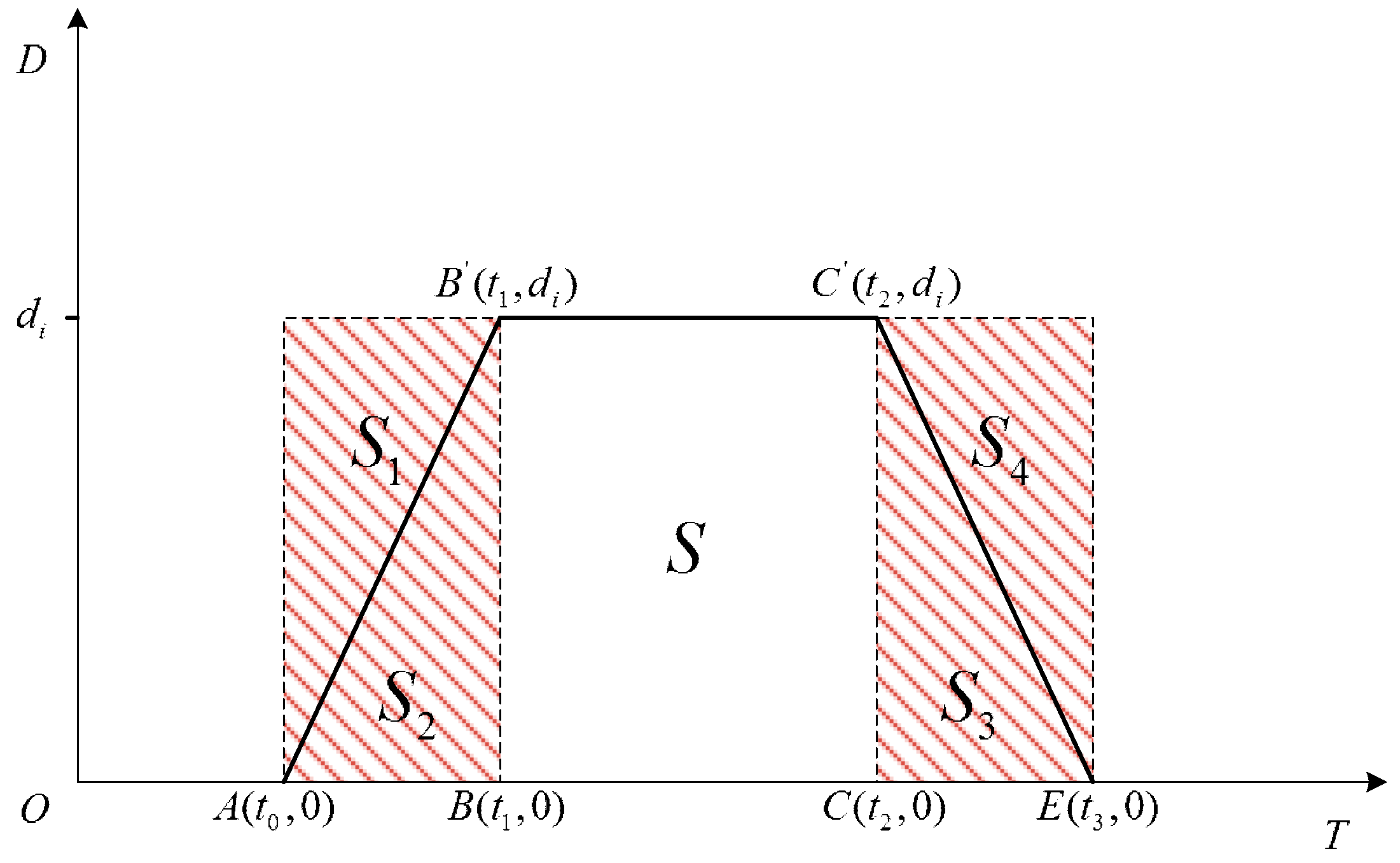
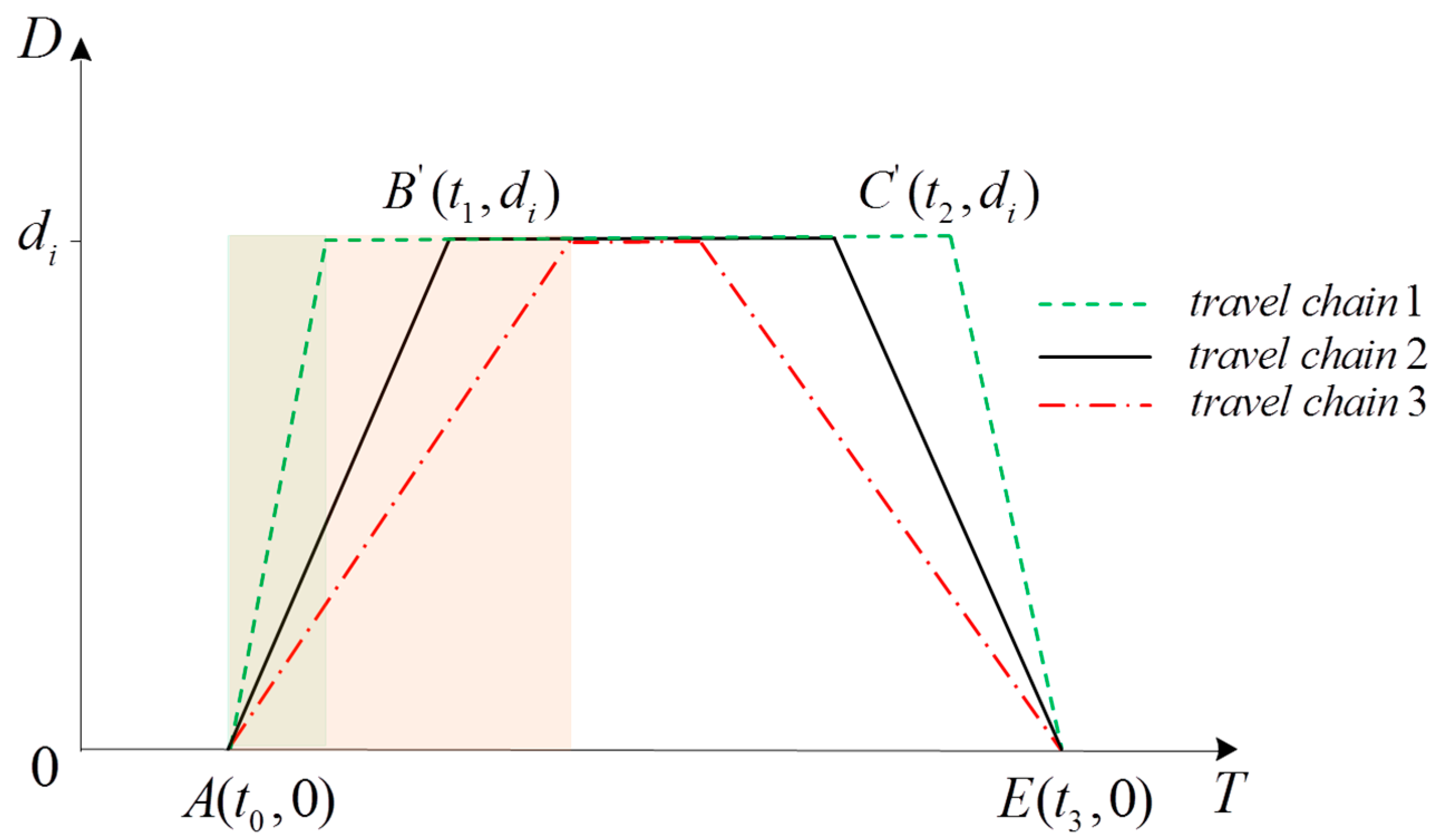
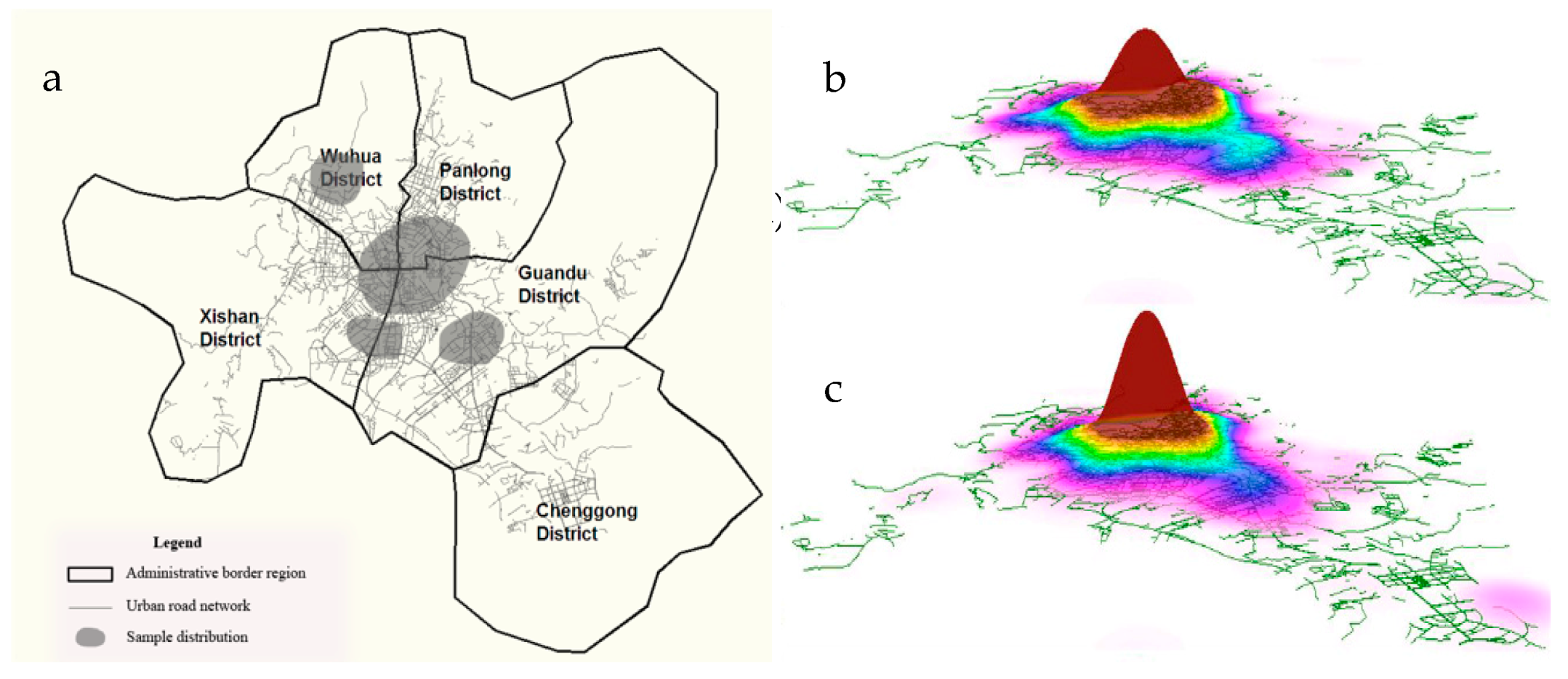
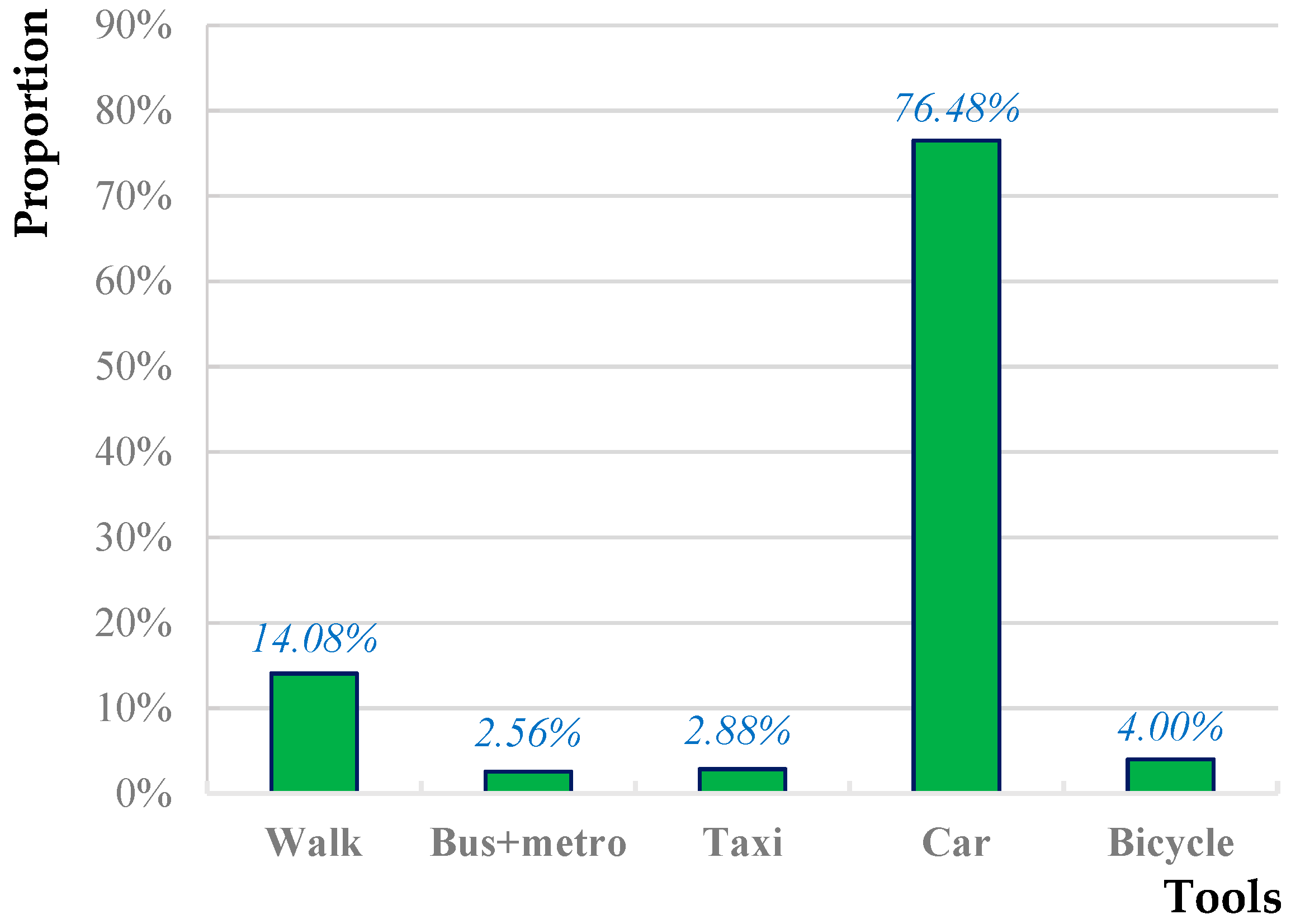
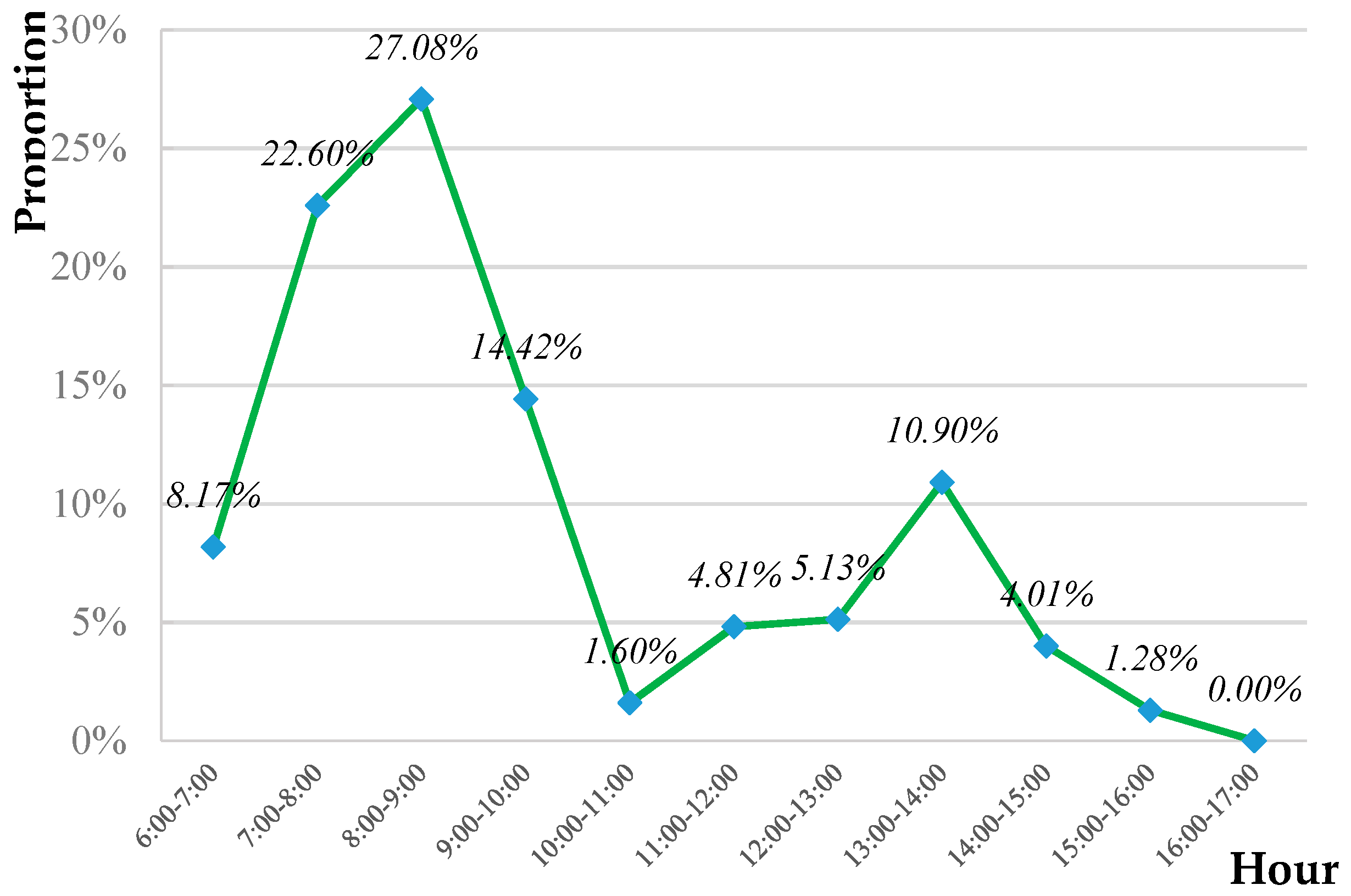
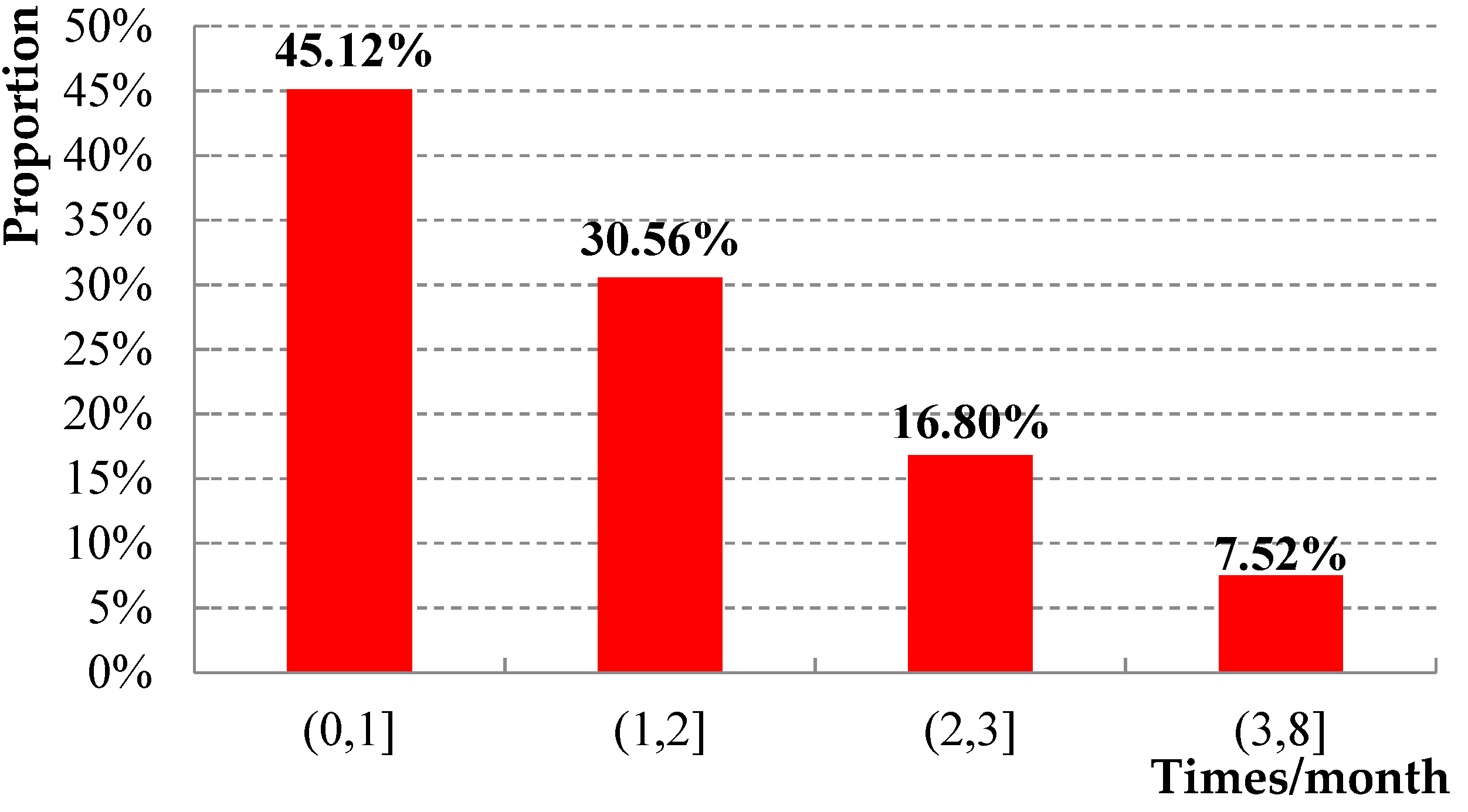
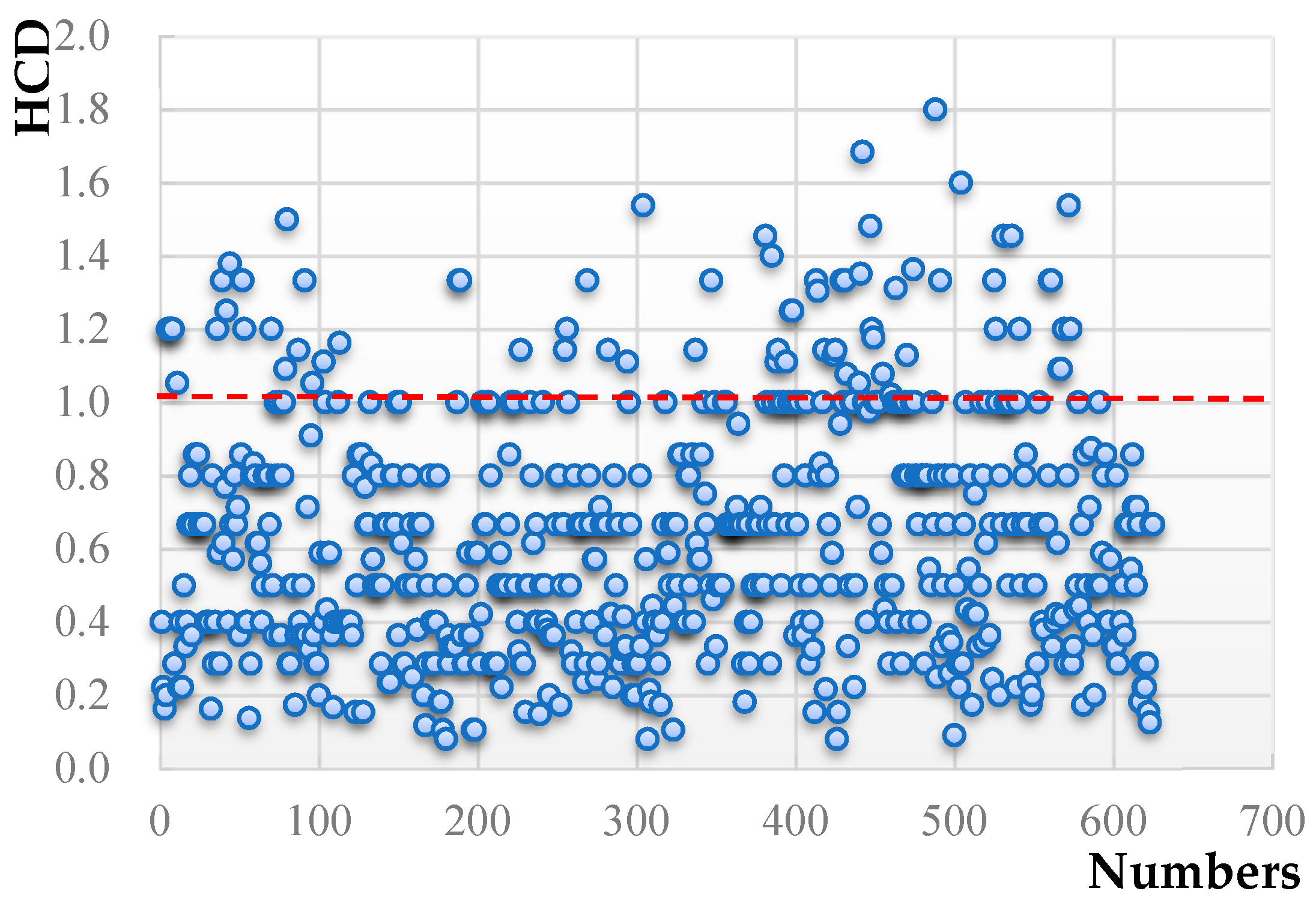
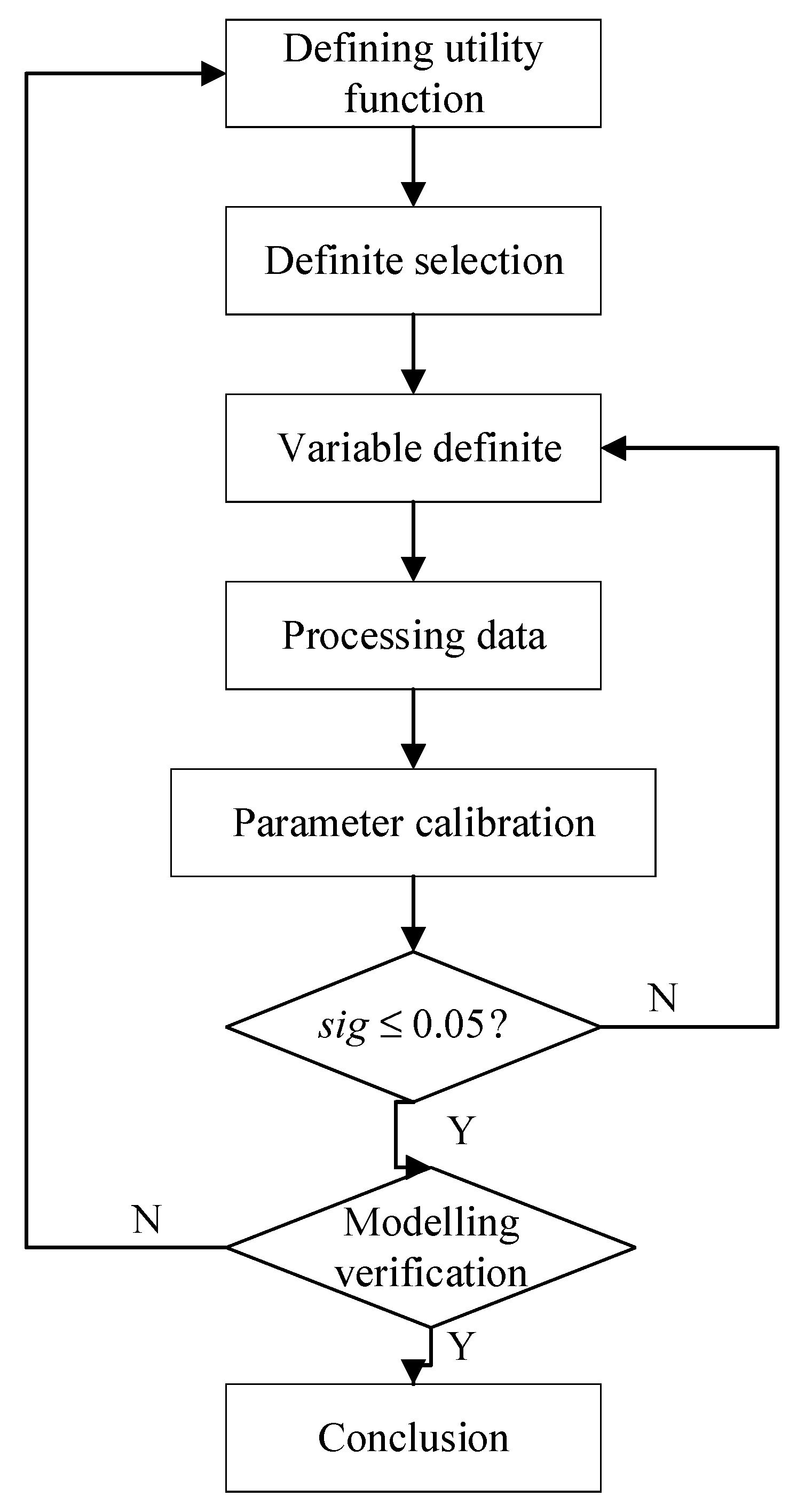
| Variable | Definition and Notes | |
|---|---|---|
| Personal attributes | Gender | Male = 1, Female = 2 |
| Age | [60,70) = 1, [70,80) = 2, >80 = 3 | |
| Family attribute | Car pick-up | Yes = 1, No = 0 |
| Number of family with driver’s license | 1 = 1, 2 = 2, >3 = 3 | |
| Accompanied by family | Yes = 1, No = 0 | |
| Travel attribute | Distance from bus stop (m) | [0,500) = 1, [500,1000) = 2, [1000,1500) = 3, >1500 = 4 |
| Travel time (min) | [0,30) = 1, [30,60) = 2, [60,90) = 3, >90 = 4 | |
| Travel distance (km) | [0,2) = 1, [2,5) = 2, [ 5,10) = 3, >10 = 4 | |
| Frequency of healthcare (time) | [0,1) = 1, [1,2) = 2, >2 = 3 | |
| Walkability | Walkable = 1, Walkable with difficulty = 2, Not walkable = 3 | |
| Healthcare purpose | Take medicine = 1, Physical examination = 2, Treatment = 3 | |
| Healthcare time (min) | [0,30) = 1, [30,60) = 2, [60,90) = 3, >90 = 4 | |
| Activity Type | Strong Constraint () | |||||||
|---|---|---|---|---|---|---|---|---|
| Characteristic Variable | Walk | Bus + Metro | Taxi | Car | ||||
| B | Sig. | B | Sig. | B | Sig. | B | Sig. | |
| Constant | 4.62 | 0.00 | −7.17 | 0.00 | 1.24 | 0.00 | 4.33 | 0.00 |
| Gender | 1.46 | 0.03 | −2.42 | 0.01 | - | - | −6.26 | 0.00 |
| Travel time | −3.63 | 0.00 | −1.14 | 0.01 | 2.37 | 0.00 | 3.21 | 0.04 |
| Travel distance | −2.11 | 0.01 | - | - | 0.82 | 0.01 | 4.22 | 0.00 |
| Distance from bus station | −0.21 | 0.00 | −0.11 | 0.00 | - | - | 1.12 | 0.01 |
| Frequency of healthcare | 0.43 | 0.00 | −0.22 | 0.00 | −1.22 | 0.02 | −0.12 | 0.01 |
| Walkability | 2.35 | 0.00 | −0.04 | 0.00 | −4.25 | 0.00 | −3.46 | 0.02 |
| Model Checking Correlation Coefficient | ||||||||
| Chi-square | 135 | Cox and Snell | 0.76 | |||||
| McFadden | 0.745 | Nagelkerke R Square | 0.86 | |||||
| Activity Type | Weak Constraint () | |||||||
|---|---|---|---|---|---|---|---|---|
| Characteristic Variable | Walk | Bus + Metro | Taxi | Car | ||||
| B | Sig. | B | Sig. | B | Sig. | B | Sig. | |
| Constant | 3.16 | 0.00 | −6.92 | 0.00 | 2.50 | 0.00 | −4.16 | 0.00 |
| Age | −1.87 | 0.00 | - | - | 4.81 | 0.02 | 9.62 | 0.00 |
| Healthcare purpose | 0.99 | 0.02 | −0.54 | 0.01 | 2.36 | 0.04 | 5.55 | 0.00 |
| Car pick-up | −9.14 | 0.04 | −6.22 | 0.02 | −7.45 | 0.00 | 14.61 | 0.00 |
| Travel distance | −1.66 | 0.03 | −0.27 | 0.00 | 1.43 | 0.00 | 2.54 | 0.01 |
| Healthcare time | −0.84 | 0.01 | 0.27 | 0.00 | 0.95 | 0.00 | 4.34 | 0.02 |
| Accompanied by family | −2.65 | 0.00 | −0.98 | 0.02 | 1.43 | 0.02 | 8.95 | 0.00 |
| Number of family with driver’s licenses | −1.15 | 0.00 | −0.67 | 0.03 | −1.32 | 0.01 | 4.37 | 0.00 |
| Model Checking Correlation Coefficient | ||||||||
| Chi-square | 148 | Cox and Snell | 0.611 | |||||
| McFadden | 0.67 | Nagelkerke R Square | 0.70 | |||||
© 2018 by the authors. Licensee MDPI, Basel, Switzerland. This article is an open access article distributed under the terms and conditions of the Creative Commons Attribution (CC BY) license (http://creativecommons.org/licenses/by/4.0/).
Share and Cite
Li, X.; Zhang, Y.; Du, M. Analysis of Travel Decision-Making for Urban Elderly Healthcare Activities under Temporal and Spatial Constraints. Sustainability 2018, 10, 1560. https://doi.org/10.3390/su10051560
Li X, Zhang Y, Du M. Analysis of Travel Decision-Making for Urban Elderly Healthcare Activities under Temporal and Spatial Constraints. Sustainability. 2018; 10(5):1560. https://doi.org/10.3390/su10051560
Chicago/Turabian StyleLi, Xuefeng, Yong Zhang, and Mingyang Du. 2018. "Analysis of Travel Decision-Making for Urban Elderly Healthcare Activities under Temporal and Spatial Constraints" Sustainability 10, no. 5: 1560. https://doi.org/10.3390/su10051560




